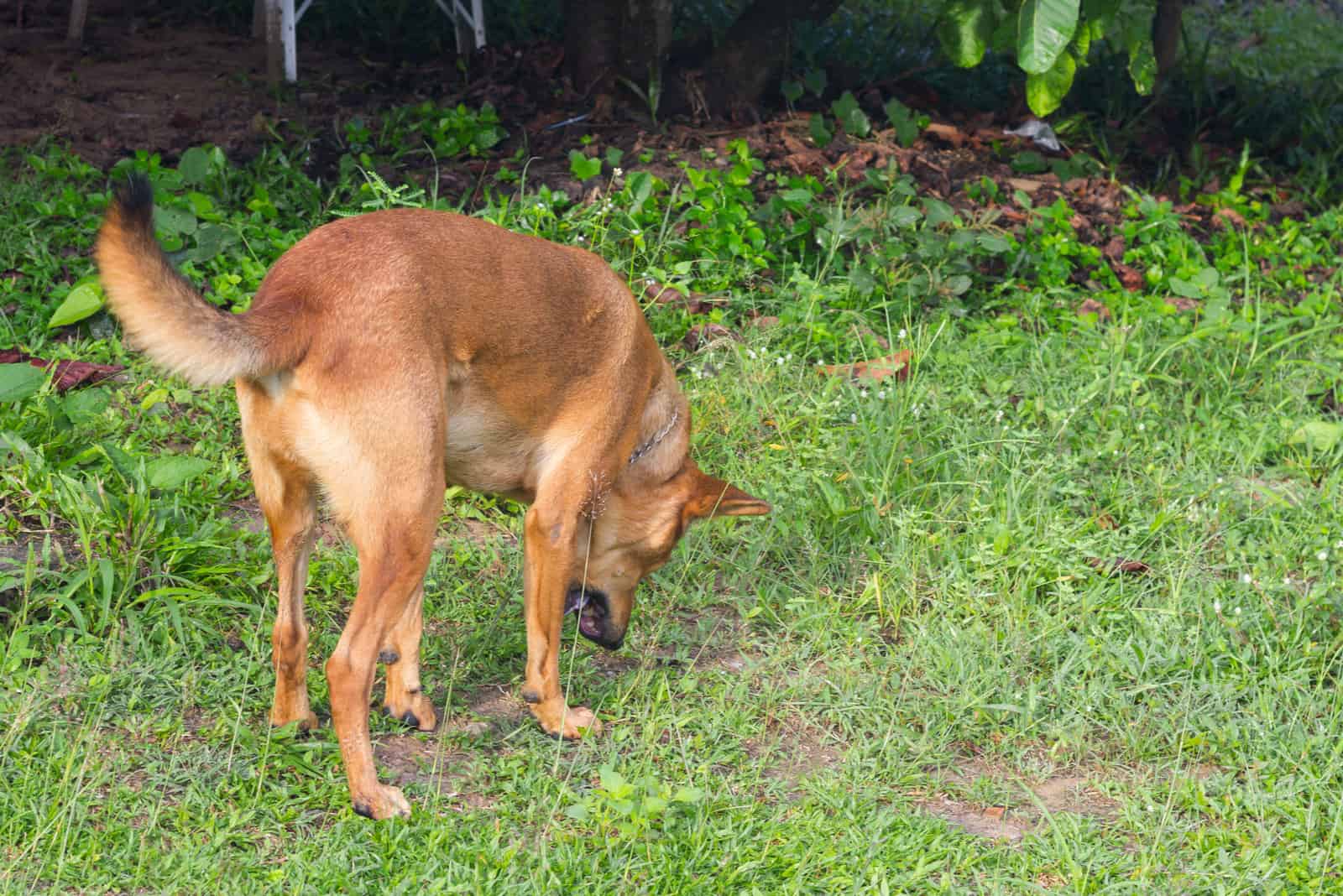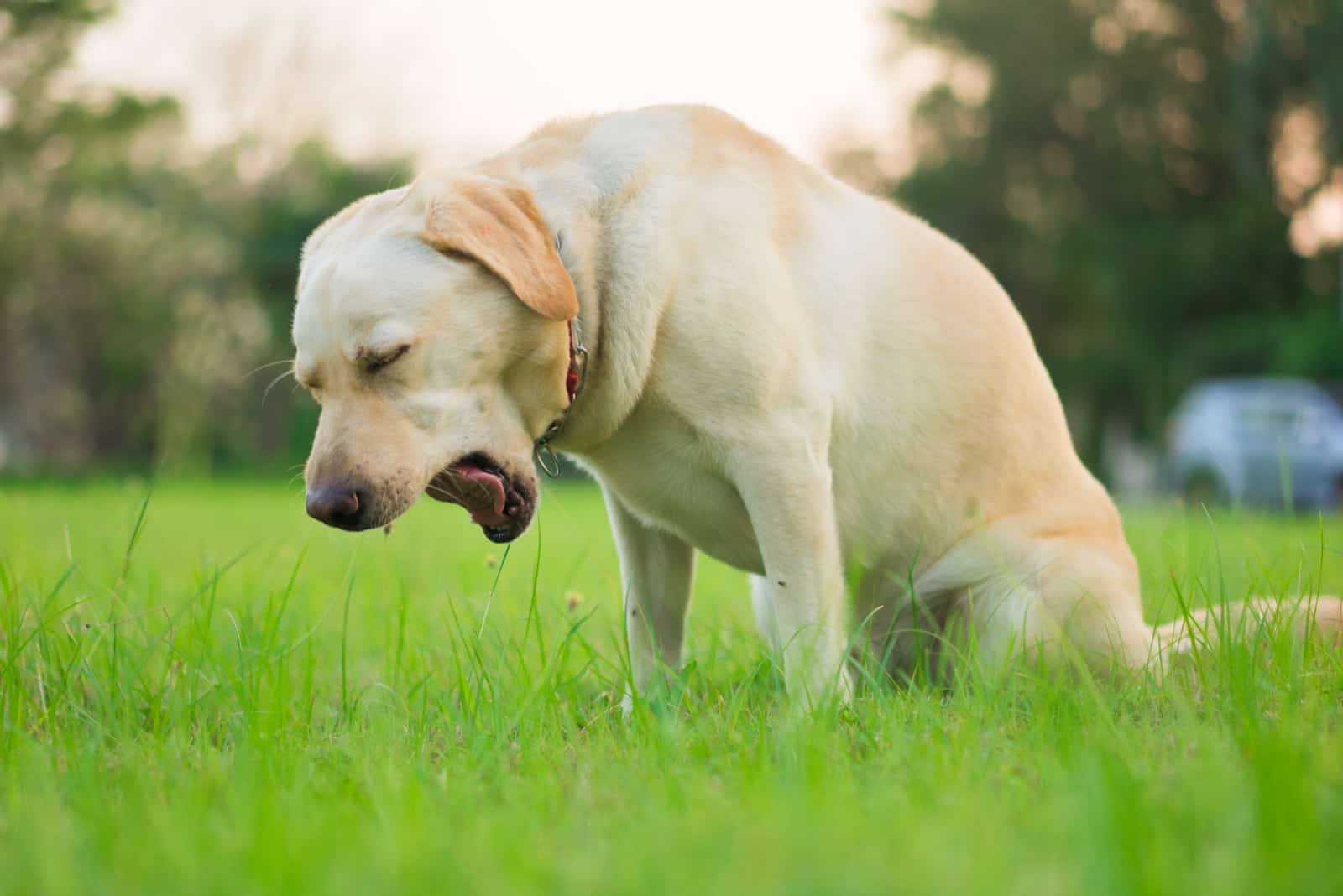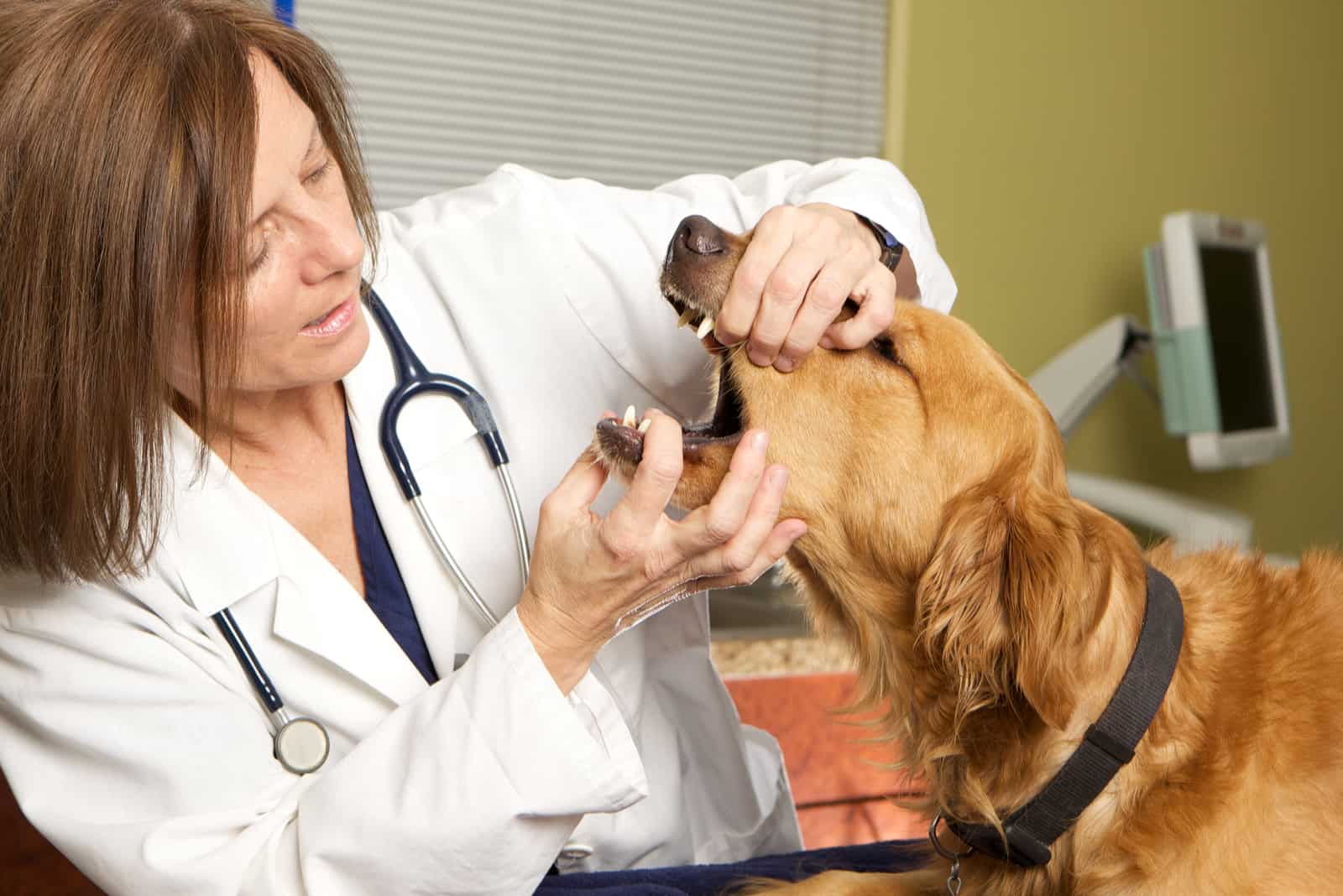You must have witnessed your dog vomit at least a few times. Just like humans, dogs sometimes have problems with vomiting. This can happen, for example, when dogs overeat or as a result of a stomach virus. Such cases are not too worrying and dogs recover from them very quickly.
However, there are situations when your dog looks like he is going to vomit, but he fails to do so and nothing comes out of his mouth. What’s this all about? This phenomenon is known as dog dry heaving.
We don’t want to scare you right at the beginning of our article, but it is good to be informed. Dog dry heaving can be completely harmless, but isn’t always. In some cases, this issue might indicate serious health problems in your pet.
Often, we all panic unnecessarily about certain symptoms in our pets, especially when they are still young. While panicking won’t do anyone any good, sometimes it’s not bad to be a little scared. This way, we will react faster and maybe help to make sure that our dog’s health doesn’t deteriorate.
Keep reading to find out all about dogs dry heaving, why they do it, and what you can do to help your beloved puppy.
Basic Information About Dog Dry Heaving

So, what does dry heaving mean? How can you recognize it? At the beginning of this article, let’s first find out what exactly dry heaving is. Also, an important thing to know first, is whether it is normal for dogs to dry heave.
Furthermore, there are some issues that occur that may remind you of dry heaving, but are not the same thing. So, let’s dive into the basic information on this matter.
What Does Dry Heaving Mean?
If you are encountering your dog dry heaving for the first time, this kind of experience may seem a little intimidating. Your dog will probably struggle with coughing and gagging and will look like he is trying to get something out of his throat. But he will not succeed.
A dog dry heaving is usually accompanied by loud dog sounds and drooling. If you’ve noticed your dog dry heaving once or twice, and then it stops, there’s usually no need to worry.
However, if something like this is repeated several times in a row and you see that your dog is suffering a lot, you should seek the help of a veterinarian immediately.
Is It Normal For Dogs To Dry Heave?
Dogs dry heaving or retching is something that every dog will deal with at some point in their life. This health condition is more often connected with large-breed dogs, such as German Shepherds, Labradors, Golden Retrievers, and Great Danes, but it can occur in any dog breed.
Why is this happening?
Does it seem that your dog has a hairball in his throat? Maybe the dog ate their food too fast, maybe he didn’t digest the food well, or he may even be telling you that he is hungry this way.
So, dog coughing and dog gagging are normal occurrences. But it is not normal if a dog is dry heaving frequently and intensely. Why? Because something like this can indicate a serious health problem. If a dog suddenly has frequent problems with dry heaving, a certain disease may have developed in his body.
Therefore, this should be a warning to the dog owner, who must react urgently by taking the dog to the vet. Although it can be completely harmless, trying to vomit without expelling any contents other than saliva can also indicate serious health conditions in dogs.
Conditions You Can Confuse With Dry Heaving
Some other occurrences are similar to dry heaving but are not the same thing. What is the main difference between dry heaving and similar issues, such as reverse sneezing, gagging, and vomiting? Let’s find out!
Reverse Sneezing
While in normal sneezing, the air is expelled, reverse sneezing involves drawing air inside, into the dog’s respiratory tract. If you encounter this phenomenon for the first time, it can seem detrimental to your dog’s health.
However, reverse sneezing is, in most cases, not something you need to worry about too much. This phenomenon can be caused, for example, by the dog’s collar being too tight, or by various strong odors, such as cleaning products or perfumes, or by excessive excitement of the dog due to some activity.
However, if reverse sneezing occurs frequently and alongside some other symptoms, such as a runny nose, it is necessary to seek the help of a veterinarian.
Gagging
If your dog has a problem with gagging, there is probably an inflammation in his throat or larynx. Gagging includes the dog’s attempt to vomit, while at the same time the dog produces a loud sound and coughs.
Gagging usually means that your dog has something stuck in his throat. In most cases, a dog will be able to spit the object out, but if not, you will need a vet.
Vomiting
Vomiting is when a dog throws up food that it has eaten. Every dog will suffer from vomiting sometimes, which means that he has certain stomach problems.
Maybe a dog has not digested certain food well, or the temperature outside does not suit him, or he is simply ill: all of these reasons could lead to a dog vomiting.
Occasional vomiting in dogs is certainly not a sign of concern. However, if you notice that your dog suddenly vomits a lot, he may be suffering from a certain health problem. Therefore, do not take risks and do not wait for what will happen next, but contact a veterinarian immediately.
So, how does dry heaving differ from reverse sneezing, vomiting, and gagging?
Unlike reverse sneezing, dry heaving comes from the dog’s stomach. Dry heaving could be hard to differentiate from gagging, but gagging usually does not last as long as dry heaving. Dry heaving does not include vomiting, only the dog’s attempt to vomit.
Why Is My Dog Dry Heaving? 10 Possible Reasons

Many causes can trigger a dog’s gag reflex, which may develop into dry heaving in dogs. Some of these causes are harmless, while some can be life-threatening. So, dry heaving might be insignificant to your pooch, but at the same time, it could demand immediate veterinary care.
Let’s look at these most common causes of dry heaving in dogs.
1. Dog Is Eating Too Fast
One of the common causes of dry heaving in dogs is dogs eating too fast. If you have noticed dry heaving in your dog, first, pay attention to the way your dog eats. If he eats food greedily and does not chew it, this may be the main cause of his dry heaving.
Is there any way you can solve this problem? Yes, and it’s really easy! Buy your dog a slow feeder bowl.
These bowls are designed in such a way that they have many obstacles, due to which, a dog will need a longer amount of time to finish the meal. In this way, you will reduce the possibility of dry heaving and your dog will acquire better eating habits, and thus, have better digestion.
2. An Object Is Stuck In Your Dog’s Throat
We all know how much dogs love to put various objects in their mouths, like balls and similar toys. If your dog is struggling with coughing and reverse sneezing, this may mean that an object is stuck in his throat and that his trachea is blocked.
In an attempt to get the object out of his throat, the dog keeps coughing and attempting to vomit.
In some cases, dogs may sneeze frequently while struggling with a foreign object stuck in their throat. If your dog is having a really hard time trying to vomit, veterinary intervention will be required to successfully remove the object from the dog’s throat.
3. Food Allergies
Sometimes dry heaving in dogs can be caused by food allergies. You may have shared your meal with your dog, as you have done many times before. We heartily recommend all dog owners not to do this, no matter how harmless it might seem.
A dog’s stomach is very sensitive and human food is not intended for dogs. In most cases, they will not be harmed, but sometimes your dog may be allergic to certain foods that you are not aware of.
If dry heaving is accompanied by swelling of the tongue or other parts of the body in your dog, this may be an allergic reaction. It is necessary to seek the help of a veterinarian as soon as possible if this is the case.
4. Dog Struggling With Parasites
Parasites are another possible reason why your dog is struggling with dry heaving. Some types of parasites, like roundworms, can be harmless and you can help your dog get rid of them by yourself, buying medicine and deworming products in a pet store.
However, some other types of parasites can seriously damage a dog’s internal organs, like heartworms.
By going to the vet, you will determine which kind of parasites your dog is struggling with. In most cases, parasite infections will not cause serious consequences for your dog. Regular visits to the vet and deworming schedules should be sufficient prevention in the fight against parasites.
RELATED: The Ugly Truth: White Specks In Dog Poop
5. Respiratory Illnesses

If your dog is struggling with dry heaving, and at the same time with an intense cough and nasal discharge, this may be a specific respiratory infection.
One of the most common respiratory problems in dogs is kennel cough. This respiratory disease is most often caused by the Bordetella bacterium.
Dogs usually recover from a kennel cough in a few days. If this is not the case, a veterinarian prescribes an antibiotic to help the dog recover as quickly as possible. However, for older dogs, kennel cough can be significantly more devastating and can often lead to pneumonia.
6. GDV (Gastric Dilatation Volvulus)
Gastric Dilatation Volvulus, or bloat, is a very serious health condition and its one symptom in dogs is dry heaving.
If the veterinarian, with the help of an X-ray, determines that your dog is suffering from bloat, which means that his stomach is turned upside down, the dog will most likely need surgery. When a dog’s stomach is flipped, the dog’s other organs are left with no blood supply.
Why does this happen?
This condition occurs when a dog’s stomach is filled with gas and food, due to which, the stomach swells. To avoid this, it is necessary to feed dogs several smaller meals instead of one large meal a day.
Also, it is necessary to pay attention to make sure that the dog does not eat too much and does not eat too fast.
7. Tumors
If your dog struggles with a dry cough, this could be a sign of a tumor in his throat, esophagus, or his lungs. This condition is very severe, so, if you notice an intense cough and dry heaving, you should visit a veterinarian right away.
If the tumor is detected in time, the dog has a great chance of healing and the opportunity for a long and healthy life.
8. Laryngeal Paralysis
If you notice dry heaving together with heavy breathing in your dog, you might be dealing with Laryngeal paralysis. This condition means that there has been an airway obstruction in your dog’s larynx. This health problem usually occurs in older dogs.
Dogs will show signs such as gagging and coughing, and they will have difficulties breathing. This health issue is very serious and dogs with these symptoms must be taken to the vet right away. If not treated, this condition might lead to death.
9. Tonsillitis
Just like humans, dogs can suffer from Tonsillitis too. This health condition usually occurs in small dog breeds and one of its symptoms is dry heaving. If this is the health issue your dog is suffering from, you will also notice that his tonsils are red and swollen.
Tonsillitis will make your dog refuse food and you will notice that he has trouble swallowing. This infection in dogs is usually treated with antibiotics.
10. Canine Distemper
Canine Distemper is a serious virus that dogs can get by droplets from an infected dog. Also, a pregnant female can transmit this virus to her puppies. This virus most often affects newborns and very young puppies, who have not yet received the canine distemper vaccine.
Canine distemper is often transmitted to dogs that are close to wild animals. If you notice dry heaving in your dog, along with a fever and decreased appetite, it is possible that he may be suffering from distemper.
This virus is not curable, and if a veterinarian determines that one dog is infected, he will need to be isolated from all other dogs.
The only way to prevent canine distemper is to get your dog vaccinated.
My Dog Is Dry Heaving: Should I Be Worried?

As we have already mentioned, every dog will probably, at some point in his life, deal with dry heaving. Although this does not have to be dangerous for the dog’s health, if the dry heaving appears together with some other symptoms, you should be worried and you should contact a vet right away.
Some of these symptoms include:
• Coughing
• Nausea
• Diarrhea
• Vomiting
• Sneezing
• Drooling
• Fever
• Difficulty Breathing
• Weakness
• Refusing to eat
• Decreased energy
So, if you have noticed dry heaving and some of the above symptoms in your dog, there is a big possibility that your dog is suffering from a serious health issue that needs to be solved with the help of professionals.
There are also some steps you can undertake to prevent dry heaving or to stop it when it appears, so, let’s find out about them.
What Can I Do To Stop My Dog From Dry Heaving?

You now know the possible reasons why your dog is having trouble with dry heaving. So, you are probably wondering, is there anything you can do before asking for help from a veterinarian?
Yes, there are some steps that you can do by yourself that can be very useful and help your dog with his dry heaving problems.
Six Ways To Help With Dry Heaving
What are the most important steps you can take at home that could stop your dog from dry heaving?
1. Check if there is anything in your dog’s mouth. If you notice something, try to help your dog to spit it out of his mouth.
2. Observe your dog as he eats. Introduce several smaller meals a day to him, and do not allow your dog to eat only one large meal a day. Also, try not to give dry kibble to your dog. If he eats only once a day, he will be hungrier, more greedy, and he will try to eat as fast as possible. This can lead to dry heaving. Furthermore, make sure your dog has access to clean water at all times.
3. Make sure that your dog doesn’t get into extreme activities immediately after he has had a meal. A dog’s body needs time to digest food, so try to show your pet how to take a little break after his meals.
4. Be careful with objects that your dog could swallow. If your dog has had situations with foreign objects getting stuck in his throat before, don’t let this happen again. Put aside all the things that the dog could swallow and make sure he can’t reach them.
5. Try him with probiotics. If your dog is having trouble with kennel cough or parasites, introducing probiotics could be very helpful to your dog. Thanks to probiotics, your dog’s immunity will return to normal faster, his appetite will increase, and thus, his digestion will be improved.
6. Make sure your dog is vaccinated. Some health issues cannot be prevented, but what you can do is have your dog vaccinated. By doing this, you can prevent illnesses such as kennel cough and distemper in your dog.
Should I Contact A Vet?
You have provided your dog with a slow feeder, you have introduced him to several meals a day, and you are constantly making sure that your dog takes a short break between meals and his daily activities.
However, the problem with his dry heaving has not stopped yet. Are you wondering if it’s time to see a vet?
If you think it’s too early to go for a checkup, what you can always do is make a phone call to the vet. This way, you can describe the symptoms present in your dog to your vet.
He will probably ask you questions about whether the dog has received the necessary vaccines, what his diet is, how old he is, and other similar questions.
If he thinks it is necessary, the veterinarian will invite you to bring your pet in, so that he can perform an examination and determine the health condition of the dog.
Even if the veterinary examination shows that your dog is completely healthy and that there are no signs of any serious health conditions, you have fulfilled your obligation. You will have received confirmation that your dog is healthy, which is the best news you can hear, am I right?
To Sum It Up

Any change in your dog can be worrying to you, even if other people don’t notice it at all. So, it is always a good idea to learn new things that are important for your dog’s health. In today’s article, we have tried to bring you closer to the phenomenon known as dry heaving in dogs.
As you may have concluded from reading this article, dog dry heaving can be a symptom of a variety of conditions.
Maybe your dog has swallowed part of an object that is now making him uncomfortable or maybe he is suffering from kennel cough.
However, the reason can be far more serious, such as bloating or throat tumors.
If you haven’t noticed dry heaving in your dog before, and now this is happening often, for several days in a row, don’t take any chances! Contact a veterinarian who will be able to make recommendations for further treatment of this health problem.
Remember: only a healthy dog is a happy dog!
Read Next: Why Is My Dog Throwing Up Yellow & How To Treat It
